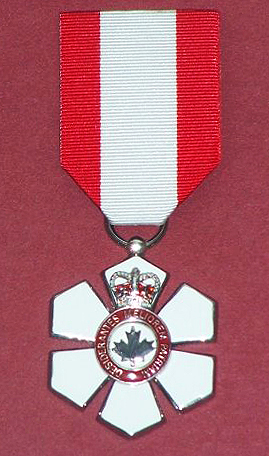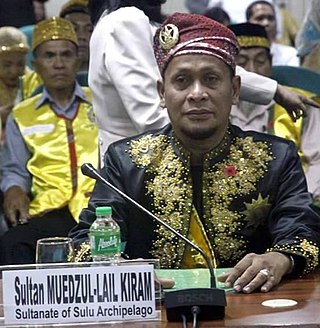
The Most Noble Order of the Garter is an order of chivalry founded by Edward III of England in 1348. The most senior order of knighthood in the British honours system, the only decorations which outrank it in precedence are the Victoria Cross and the George Cross. The Order of the Garter is dedicated to the image and arms of Saint George, England's patron saint.

The Order of Canada is a Canadian state order and the second-highest honour for merit in the system of orders, decorations, and medals of Canada, after the Order of Merit.

The Most Excellent Order of the British Empire is a British order of chivalry, rewarding contributions to the arts and sciences, work with charitable and welfare organisations, and public service outside the civil service. It was established on 4 June 1917 by King George V and comprises five classes across both civil and military divisions, the most senior two of which make the recipient either a knight if male or dame if female. There is also the related British Empire Medal, whose recipients are affiliated with, but not members of, the order.

The Most Honourable Order of the Bath is a British order of chivalry founded by King George I on 18 May 1725. The name derives from the elaborate medieval ceremony for appointing a knight, of which bathing was an element. Knights so created were known as 'Knights of the Bath'. George I constituted the Knights of the Bath a regular 'Military Order'. He did not revive the Order of the Bath, which had not previously existed as an Order, in the sense of a body of knights governed by a set of statutes and whose numbers were replenished when vacancies occurred.

The Order of the Companions of Honour is an order of the Commonwealth realms. It was founded on 4 June 1917 by King George V as a reward for outstanding achievements. It was founded on the same date as the Order of the British Empire.

The Most Distinguished Order of Saint Michael and Saint George is a British order of chivalry founded on 28 April 1818 by George, Prince of Wales, the future George IV, while he was acting as prince regent for his father, King George III.

The New Zealand Order of Merit is an order of merit in the New Zealand royal honours system. It was established by royal warrant on 30 May 1996 by Elizabeth II, Queen of New Zealand, "for those persons who in any field of endeavour, have rendered meritorious service to the Crown and nation or who have become distinguished by their eminence, talents, contributions or other merits", to recognise outstanding service to the Crown and people of New Zealand in a civil or military capacity.

The coat of arms of Jordan or the emblem of the Hashemite Kingdom of Jordan is the arms of dominion for the king of Jordan. The emblem was initially adopted by Abdullah I, the emir of Transjordan, in 1921. The emblem continued to be used after Transjordan emerged as an independent kingdom in 1946.

The Most Exalted Order of the Star of India is an order of chivalry founded by Queen Victoria in 1861. The Order includes members of three classes:
- Knight Grand Commander (GCSI)
- Knight Commander (KCSI)
- Companion (CSI)

The Sultanate of Sulu was a Muslim state that ruled the Sulu Archipelago, costal areas of Zamboanga City and certain portions of Palawan in the today's Philippines, alongside parts of present-day Sabah, North and East Kalimantan in north-eastern Borneo.

The Gallipolli Star is a military decoration awarded by the Ottoman Empire. It was known as the Ottoman War Medal or the Iron Crescent. It was instituted by Sultan Mehmed V on 1 March 1915 for gallantry in battle. This decoration was awarded for the duration of World War I to Ottoman and other Central Powers troops, primarily in Ottoman areas of engagement.

Muedzul Lail Tan Kiram is the head of the Royal House of Sulu, a position which he has held since 16 February 1986. As the eldest son of the former Sultan Mohammad Mahakuttah Abdulla Kiram, he is the legitimate heir claimant to the throne of the Sultanate of Sulu. He is a pretender to the throne as the 35th Sultan of Sulu.
The Royal House of Sulu is an Islamic royal house which ruled the Sulu Sultanate. In 1962, the Philippine Government under the leadership of President Diosdado Macapagal, who himself was a distant cousin of the Sulu Sultans, counting among his ancestors Princess Laila Menchanai of Sulu, the Great Grandmother of the Muslim king of Manila, Rajah Sulayman, officially recognized the continued existence of the Royal Sultanate of Sulu.
The Royal Order of King George Tupou I is a knighthood order of the Kingdom of Tonga.
The Exalted Order of the Crown of Kedah is an honorific order of the Sultanate of Kedah
The Illustrious Order of Loyalty to Sultan 'Abdu'l Halim Mu'azzam Shah is an honorific order of the Sultanate of Kedah

Datu Sadja is a senior titled nobility in the Royal Sultanate of Sulu. It is subordinate to the Datu or Su-sultanun which is acquired purely by inherited lineage or formal relationship to the Sultan. The title of Datu is roughly comparable to European sovereign princes or dukes while the title Datu Sadja can be analogous to a marquess or count. The rights of the present day customary titles are protected by a special law in the Philippines known as "The Indigenous Peoples Rights Act of 1997". This law allows traditional leadership titles to be conferred, including the title Datu, in a manner specified under the law's implementing rules and regulations which was issued as Administrative Order No. 1, Series of 1998, by the National Commission on Indigenous Peoples and written specifically under Page 11, Rule IV, Part I, Section 2, Paragraph A-C.

Emmanuel Bushayija is the claimant to the historical Kingdom of Rwanda, which was abolished in 1961. He was proclaimed the ceremonial successor to the royal title (Mwami) on 9 January 2017 under the reign name Yuhi VI. He succeeded his late uncle King Kigeli V and is a grandson of King Yuhi V.















